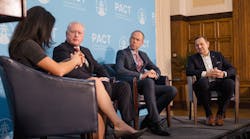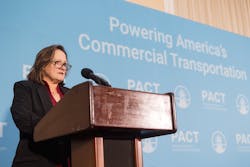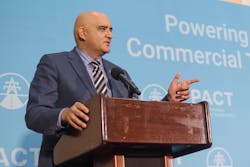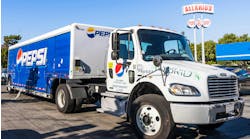WASHINGTON, D.C.—The U.S.’s major truck OEMs have proven they can build electric heavy-duty vehicles, but the nation doesn’t yet have the infrastructure to support zero-emission freight coast-to-coast. It’s enough of a challenge to create a rare sight here in the nation’s capital: the chief executives of Daimler Truck North America, Navistar, and Volvo Trucks North America sharing a stage and agreeing they need a shared voice to meet their lofty corporate decarbonization paths.
The OEM presidents were touting their parts as founding members of a new coalition focused on education and advocacy for building a nationwide zero-emission fueling infrastructure for medium- and heavy-duty vehicles. They were joined by federal energy, transportation, and White House officials to celebrate the new Powering America’s Commercial Transportation coalition, or PACT.
“This is bringing together people like us that never used to talk to each other,” John O’Leary, DTNA CEO and president, said from a shared stage at the National Press Club. “We never did. In fact, we might have talked about each other—but we never talked to each other. So it’s really encouraging to be up here hearing what is coming out of their mouths.”
See also: No juice, no EVs: Utilities weak link in fleet transition
While sitting beside Navistar CEO and President Mathias Carlbaum and VTNA President Peter Voorhoeve, the DTNA leader said PACT has great promise because the OEM leaders share a common vision and goal. “The commitment is there from our industry,” O’Leary noted. “All we’re saying is we need some help. We want other players out there—whether it’s utilities, whether it’s equipment manufacturers, all that—we need everybody in this game together and then all rowing in the same direction.”
Voorhoeve said the leaders are moving into a new era. “We like to say, ‘partnership is the new leadership.’ You don’t often see us all on the same stage.”
In Europe, Volvo Group and Daimler are partnering on a hydrogen fuel cell electric heavy-duty powertrain called Cellcentric. The VTNA leader said they are partnering to drive decarbonization forward. “It’s super important now to get people around the table that don’t normally speak to each other in order to drive speed to market and get this done. So it’s actually a good day.”
All three companies produce about 70% of all the new medium- and heavy-duty trucks in the U.S., and represent five of the seven largest truck OEMs in North America: DTNA produces Freightliner and Western Star, Navistar makes International Trucks, and the Volvo Group builds Volvo Trucks and Mack Trucks here in the U.S. The three corporations also have goals to become carbon neutral by 2050 and have similar plans to sell all net-zero-emission vehicles by 2040.
“We’re on this journey here with or without regulations,” Carlbaum said.
He noted the OEMs have data on the hundreds of thousands of commercial vehicles on the road. “You can kind of see how we can plan the mid- and long-term for these corridors but still be mindful of the shorter term,” Carlbaum said of where trucking charging infrastructure “roots” will begin, noting that it needs to be based on freight and energy costs.
Educating the nation on ZE transport
Along with bringing together OEMs to advocate for zero-emission support, the PACT is focusing on education because there is still a lot that legislators, regulators, and other policymakers are learning about the challenges to creating a decarbonized U.S. supply chain.
While most U.S. charging infrastructure projects have focused on light-duty passenger vehicles, electrifying the trucking industry is a more significant challenge. According to the International Council on Clean Transportation, the U.S. needs nearly 600,000 chargers to support the 1.1 million Class 4-8 ZEVs expected in operation by 2030. Those commercial vehicles would use some 140,000 megawatts of electricity daily, the same energy 4.9 million U.S. homes use daily.
“Through PACT, we will spend a lot of time educating and helping the utility sector, helping the fleet sector, helping others really understand about the technology that’s needed,” Dawn Fenton, VP of public affairs for Volvo Group, said during a round table discussion with trucking industry media after the launch event in which she was announced as PACT chairperson.
See also: Orange EV blossoms in Kansas City
“If we’re going to be successful in the OEMs reaching our goals, the government reaching their goals, and the environmental community reaching their goals, we all need to pull up these obstacles and roadblocks.”
She said some help could come through local legislation to alleviate or expedite utility permitting and zoning processes.
Ritchie Huang, Daimler AG executive manager for safety and government affairs, noted that while there are more than 60,000 public light-duty vehicle chargers, there are just 10 for heavy-duty trucks.
By working with the other PACT founding members, Huang said the coalition is looking to increase the focus on medium- and heavy-duty ZEVs. Along with the three OEMs, founding members include ABB E-mobility, Burns & McDonnell, Greenlane, J.B. Hunt Transport, Prologis, and Voltera.
“We want all our founding members to help with that,” Huang, who represents Daimler on PACT, told trucking media. “You’re starting to see the different needs that they do have. Utility companies have their challenges. Fleets have challenges. I think one of the key things for us is getting ourselves in sync. That’s probably the first step.”
He noted that utilities are telling some fleets it could take more than a decade to provide them enough power to build out depot charging. According to a recent North American Council for Freight Efficiency study, truck depots can be the best way to scale up ZEV fleets. PACT will focus on getting everyone—OEMs, fleets, utilities, regulators—on the same page because coordination is still a problem for fleet electrification, Huang said.
“The trucking industry is critical to the United States,” Huang added. “About 70% of all freight is on medium- and heavy-duty trucks. It’s massive. We have fewer vehicles, but we have a higher impact on the economy. And we need to start educating with that—because it’s not widely known what truck needs and requirements are.”
Chicken or the egg: ZEV or the infrastructure
Part of the educational goal is to ensure policymakers who appoint utility regulators understand that they need infrastructure for zero-emissions vehicles to succeed. And the infrastructure needs more ZEVs to be viable.
“There is no question this is kind of a chicken or an egg issue,” Brien Sheahan, interim head of government affairs at Navistar and PACT coalition member, said before the PACT launch event. “Historically, utilities don't pre-invest or prebuild, but the idea is that we need to persuade them that it makes sense and can be actually good for ratepayers over the long term. ‘No regret zones’ allow utilities to make those investments ahead of demand to open up BEV markets. And so that's certainly something that's going to be on our agenda.”
See also: More funding for charging and alt-fuel infrastructure
While supporting the commercial ZEV infrastructure growth, PACT leaders said the coalition will not advocate for specific vehicle, power generation, or utility distribution technologies. It is also about finding solutions to meet increasing emissions regulations aimed at the transport industry and its manufacturers.
“I would call it good creative tension,” O’Leary said of clean fleet regulations pushing manufacturers. “There needs to be that. It can’t be that somebody who may not know much about our business says here’s what you need to do while we’re like, ‘That’s not possible.’ But that’s not been happening. I think there’s been really good collaboration with all the various agencies along the way.
“Sometimes it gets forgotten in Washington, D.C., these days, but compromise is a good thing. It can’t be that one side gets everything to the exclusion of zero for the other. So I think that’s the type of relationship that we’ve had. And we obviously expect that to continue. And maybe even with a little more speed again so that we can ultimately get to the ‘35, or ‘39, or ‘40. The clock is ticking.”
Endeavor Business Media Commercial Vehicle Group editorial director Kevin Jones contributed to this article.






